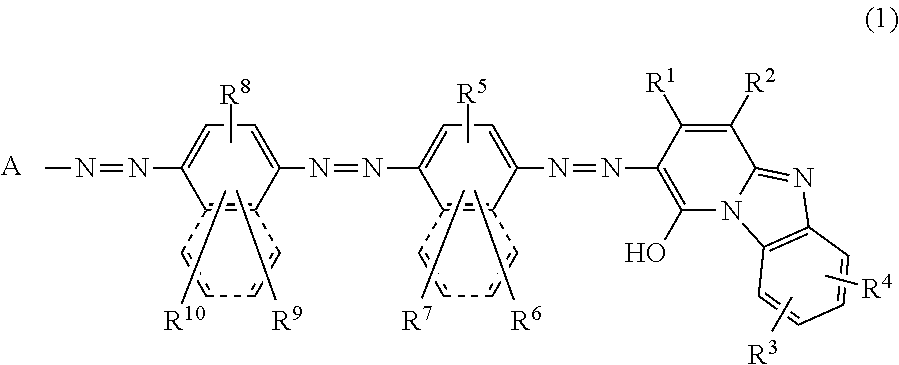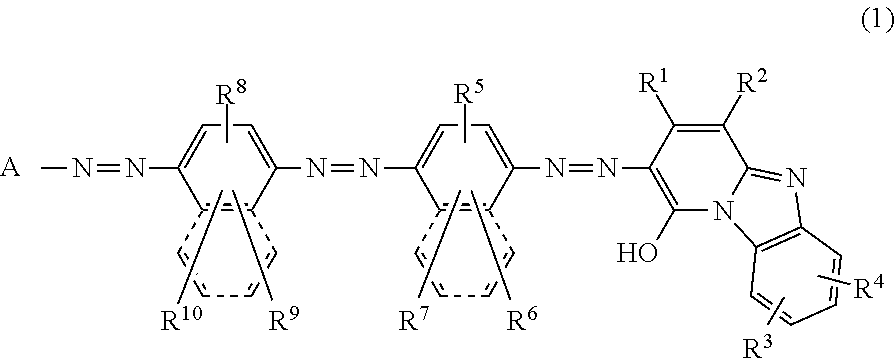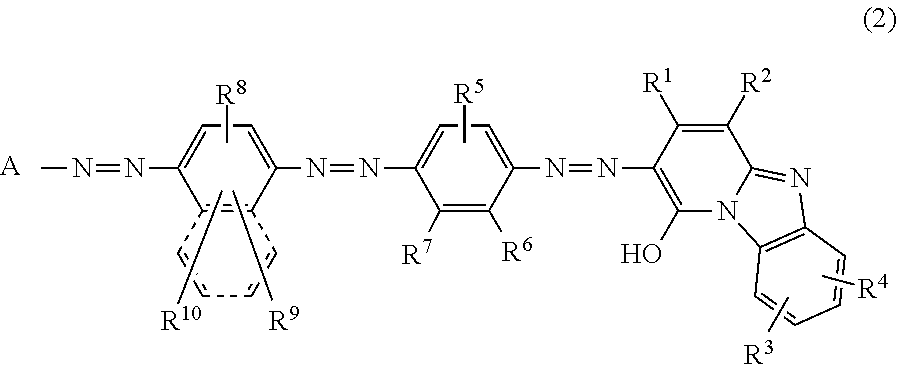Trisazo compound, ink composition, recording method and colored body
a technology of trisazo compound and ink composition, which is applied in the field of trisazo compound, ink composition, recording method and colored body, can solve the problems of inferior color rendering properties, products that meet market requirements have not yet been provided, and ozone gas resistance, and achieves superior water solubility, high print density, and easy synthesizing and inexpensive
- Summary
- Abstract
- Description
- Claims
- Application Information
AI Technical Summary
Benefits of technology
Problems solved by technology
Method used
Image
Examples
example 1
(Step 1)
[0204]A mixture of 17.1 parts of 4-chloro-3-nitrotoluene, 22.0 parts of sodium 3-mercaptopropane sulfonate, and 60 parts of dimethyl sulfoxide was heated to 60° C. while stirring, and thereto was added 11.2 parts of sodium carbonate. After the addition, the mixture was heated to 120 to 130° C., and stirred at the same temperature for 6 hrs. After the reaction liquid was cooled to room temperature, 330 parts of 2-propanol was added thereto. The deposited solid was separated by filtration, and the obtained solid was washed with 100 parts of 2-propanol. After thus obtained solid was added to 300 parts of water, the pH value was adjusted to 7.0 to 7.5 with 35% hydrochloric acid. Then, salting-out was carried out by adding sodium chloride, and the precipitated matter was separated by filtration to obtain a wet cake containing a compound represented by the following formula (16).
[0205]
(Step 2)
[0206]To 120 parts of water were added 16.6 parts of iron powder and 3.1 parts of 35% hyd...
example 2
(Step 1)
[0223]To 80 parts of a 25% aqueous sodium hydroxide solution were added 250 parts of water, 16.2 parts of tetrabutylammonium bromide and 25 parts of hydroquinone, and to the mixture was added dropwise over about 2 hrs a solution prepared by adding 180 parts of toluene to 88 parts of 1,3-propane sultone at 20° C. to 30° C. The reaction was allowed to proceed at the same temperature for 12 hrs to obtain a compound represented by the following formula (25). To the obtained compound was added 260 parts of acetic acid, and 17.0 parts of 60% nitric acid was slowly added dropwise while stirring at 15° C. to 25° C. After allowing the reaction to proceed at the same temperature for 2 hrs, the deposited solid was separated by filtration to obtain a wet cake containing a compound represented by the formula (26). An aqueous solution was obtained by adding to half amount of the obtained wet cake containing the compound 200 parts of water, and sodium hydroxide to adjust the pH to 6.0 to 6...
example 3
(Step 1)
[0227]To 60 parts of N-methylpyrrolidone was added 15.6 parts of 4-amino-2-nitrophenol, and 12.3 parts of anhydrous acetic acid was added dropwise at 10 to 20° C. while stirring over about 5 min. After the reaction was allowed at the same temperature for 1 hour, the mixture was added dropwise to 70 parts of ice water over about 5 min. The deposited solid was separated by filtration and dried to obtain a compound represented by the following formula (29). To the obtained compound was added 60 parts of N-methylpyrrolidone, and 18.3 parts of 1,3-propane sultone was added dropwise while stirring at 70 to 80° C. over about 30 min. After the reaction was allowed at 110 to 120° C. for 3 hrs, the reaction liquid was cooled to 20 to 30° C., and 300 parts of isopropanol was added thereto. Thereafter, the deposited solid was separated by filtration to obtain a wet cake containing a compound represented by the following formula (30). Next, to the wet cake containing the compound represe...
PUM
| Property | Measurement | Unit |
|---|---|---|
| temperature | aaaaa | aaaaa |
| temperature | aaaaa | aaaaa |
| temperature | aaaaa | aaaaa |
Abstract
Description
Claims
Application Information
 Login to View More
Login to View More - R&D
- Intellectual Property
- Life Sciences
- Materials
- Tech Scout
- Unparalleled Data Quality
- Higher Quality Content
- 60% Fewer Hallucinations
Browse by: Latest US Patents, China's latest patents, Technical Efficacy Thesaurus, Application Domain, Technology Topic, Popular Technical Reports.
© 2025 PatSnap. All rights reserved.Legal|Privacy policy|Modern Slavery Act Transparency Statement|Sitemap|About US| Contact US: help@patsnap.com



